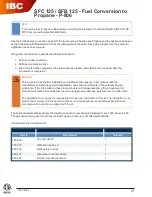
10
warmhaus.com
2.2.10. Installation at Partially Protected Exteriors
Installation instructions:
This combi can be installed in partially protected
exteriors. Partially protected place means that the combi is located at places
without direct exposure to atmospheric factors and precipitations (rain,
snow, etc.).
Frost protection:
Combi device is equipped with a system that prevents frost
by automatically activating the pump and boiler when the internal water is
lower than 5°C.
Frost protection function only depends on below given conditions:
- If the combi is correctly connected to gas and electrical sources;
- If the combi is supplied from gas and electricity sources (if the main switch
is open) in a fixed way;
- If the Combi is not in failure situation due to lack of ignition;
- In order to maintain circulation of installation water, installation valves and
radiator valves under the combi must be open.
Under these conditions, the combi is protected against frost up to -5°C
environment temperature.
Lowest Temperature -5°C.
In case the combi is installed in an environment
with a temperature lower than -5°C, and gas supply is interrupted or passed
into failure due to failing to make ignition, Frost Prevention System shall not
be activated and frost/failure shall occur in the device. Following instructions
should be followed for preventing the risk of frost:
- Heating circuit, into antifreeze (special heating devices) a good brand of
antifreeze manufacturer's instructions are followed carefully so as it deems
necessary for the rate and the minimum temperature is desired to be stored in
the heater frost protection with the matter.
Materials used for manufacturing the combi are resistant against glycol and
propylene based anti-frost liquids. Follow warnings of supplier company
regarding their lives and possible disposals.
Frost / icing protection of the combi is guaranteed only under these
conditions:
Damages arising from failing to follow above mentioned issues and
interruption of electricity supply shall be excluded from validity of the
warranty.
In case the combi device is installed at places with temperature lower than
0°C (both for tap water ad radiator purposes) both radiator installation and
tap water pipes must be insulated.
2.2.11. Electrical Connections
Electrical safety of combi shall be realized if completely connected to an
effective earthing installation that follows safety instructions in force. No
earthing shall be made from the neutral line on the socket for places not
having earthing! It is dangerous and unacceptable to use gas and water
connection pipes for earthing.
WARMHAUS A.Ş. cannot be held as responsible for any damages and
losses on individuals or commodities arising from failing to provide
earth connection of the combi and not being provided by a competent
electrician in accordance with directives and standards in force.
Also, ensure that the electricity installation complies with the maximum power
to be supplied as indicated in technical specifications label on the combi. Combi
is given with "X" type socketless special power source cables. "Warmhaus combi
has an IPX5D protection level. Power supply cable should be connected by relying
on earth connection and L-N poles in a 230 V +%10; -%15 50Hz grid, high voltage
category 3rd class multiple pole disconnector should be envisaged on the same
grid. Apply out Authorized Warmhaus Service for replacement of the cable.
2.2.9. Filling the siphon for Condensation Line
After the wall hanging operation of condensing combi, electrical connections,
radiator lines, hot tap water connections and condensation water drainage
line are completed, condensation siphon should be filled with water (Figure
9).
Condensation line drain line impermeability should be maintained.
However, prior to installation of the flue bend of the siphon in the
combi, discharge 1 litre water to the internal flue against the
possibility of flue gas leakage possibility at first start. Thus, waste gas leakage
possibility shall be prevented with the water available in siphon.
Slope of condensation water hose and line must be always towards down.
Attentions For Condensate Drain:
FAILURE TO INSTALL THE CONDENSATE DISCHARGE PIPEWORK
CORRECTLY WILL AFFECT THE RELIABLE OPERATION OF THE BOILER
1. Ensure the discharge of condensate complies with any national or local
regulations in force.
2. The discharge pipe should be run in a proprietary drain pipe material e.g.
PVC, PVC-U, ABS, PVC-C or PP.
3. Metal pipework is NOT suitable for use in condensate discharge systems.
4. Any condensate discharge pipework external to the building (or in an
unheated part of it e.g. garage) must be insulated to protect against frost.
5. In all cases discharge pipe must be installed to aid disposal of the
condensate. To reduce the risk of condensate being trapped, as few bends
and fittings as possible should be used.
6. When discharging condensate into a soil stack or waste pipe the effects
of existing plumbing must be considered. If soil pipes or waste pipes are
subjected to internal pressure fluctuations when WC's are flushed or sinks
emptied then back-pressure may force water out of the boiler trap and
cause appliance lockout.
7. Condensate outlet shall not be modified or blocked always be downwards.
Figure 9
Filling the condensation siphon
1 liter











































